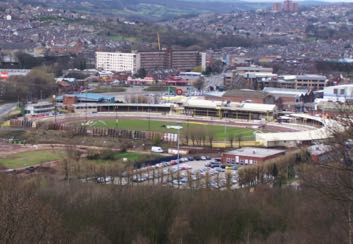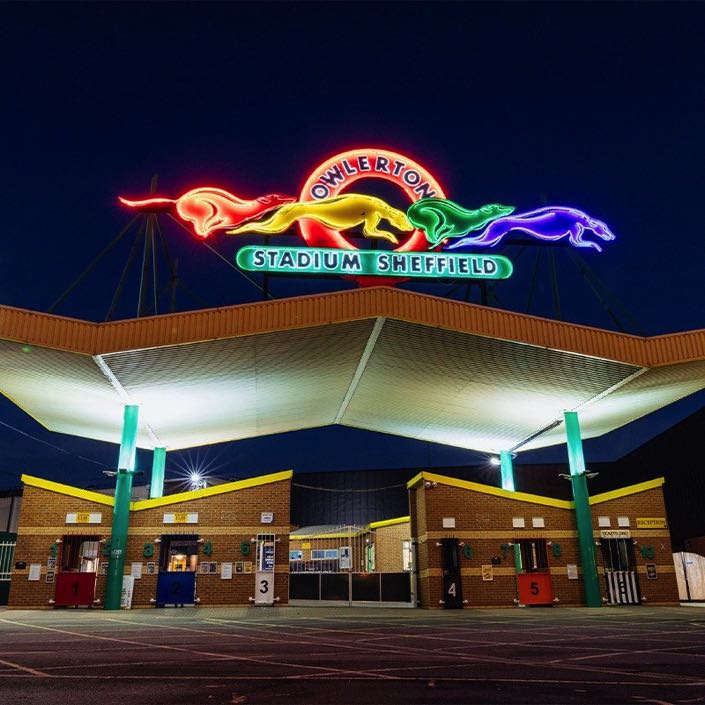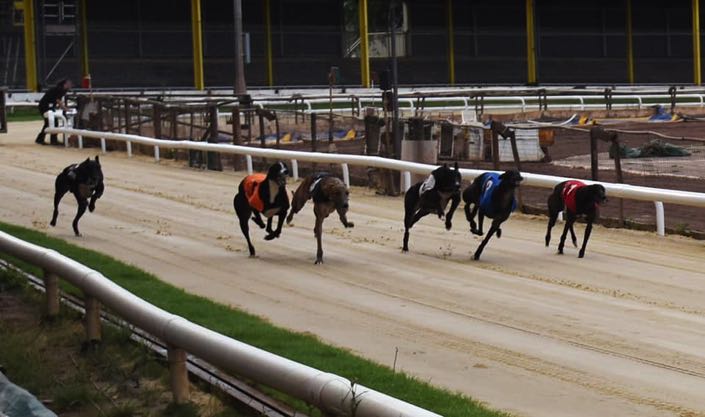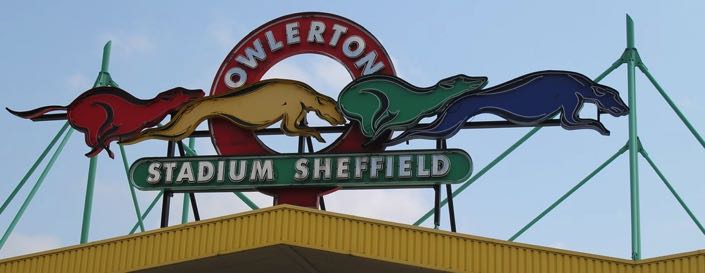- Address: Penistone Rd, Sheffield S6 2DE
- Telephone: 01142 343074
- Website: owlertonstadium.co.uk

Also known as Sheffield Stadium, Owlerton Stadium was built in 1929 and hosts both speedway and greyhound racing. Located in the Owlerton area of Sheffield, after which it is named, it was purpose-built for the Sheffield Tigers speedway team, with greyhound racing starting three years later. On top of both the dogs and speedway events, the stadium also welcomes stock car racing from time to time, which is why it is considered to be a multi-purpose venue. With a capacity of 4,000, there is plenty of room for fans of whichever sport it’s hosting.
Owned and operated by A & S Leisure Group, the stadium has also played host to the Sheffield Eagles rugby league team, who played their first ever game in the venue in 1984 before moving to Don Valley Stadium. When Don Valley was demolished in 2014, the team briefly returned to Owlerton Stadium. There is even a link to association football, given that the majority shareholder of A & S Leisure Group at the time of writing is Dave Allen, who was previously the chairman of Sheffield United Football Club. Greyhound racing at the stadium takes place five days a week.
The Track & Facilities

The facilities at Owlerton Stadium are extremely impressive, not least thanks to the presence of the modern-looking and glass-fronted Panorama Restaurant. That can welcome up to 300 guests, with experienced chefs promising three-course menus. If you’d rather splash out for a more private time then you can opt for a VIP box, whilst if you’d rather be a bit more relaxed then you can head to either the Paddock Bar or Napoleons Bar, both of which allow for excellent views of the track so you can still enjoy the racing in style. When you’ll need to go will depend on what time you want to watch the racing.
If you’re a fan of evening racing, then you can enjoy some on the evenings of Monday, Tuesday, Friday and Saturday, whereas those that prefer daytime viewing can head there on Thursdays. It should be noted, though, that if you want to see racing on Monday or Thursday then you’ll need to be an owner of a greyhound that is part of the running, given the fact that the stadium is closed to the public on those days. Regardless, it is the perfect place to head if you enjoy a party, conveniently located about five minutes from the centre of Sheffield.
How many races you’ll see will depend on the day, given that there are currently 14 run on a Tuesday, ten on a Friday and 16 on a Saturday, with all options subject to change. At the time of writing, you can enjoy races run over the following distances:
- 280 Metres
- 480 Metres
- 500 Metres
- 660 Metres
- 720 Metres
- 800 Metres
- 915 Metres
- 934 Metres
- 500 Metre Hurdles
Major Races & Events

As with all of the major greyhound venues, Owlerton Stadium boasts a few big tournaments that it is worth telling you about. Some of them, such as the Northern Sprint and the Puppy Cup, are generic in nature and don’t offer a lot of information. Others, such as the Ebor Stakes, used to be run here but no longer are. As a result, what we’re telling you about here are the current races that you can witness if you head to the stadium at the right time.
Steel City Cup
There are very few sports or stadiums based in Sheffield that don’t have some sort of competition named along the lines of the Steel City, so it’s not surprising that the greyhound arena of the city fits into that bracket. First run in 1970, it has taken place every year since and has boasted numerous different sponsors since then. Unsurprisingly, most of them have been bookmakers, including the likes of William Hill and Betfair. The likes of Gulleen Cove and Roxholme Nidge are notable for winning the event, which takes place over 500 metres, more than once.
Three Steps to Victory
A much more modern event than the Steel City Cup, the Three Steps to Victory race was inaugurated in 2003. Run over three distances, hence its name, the winner was awarded £10,000 in 2021. The fact that it boasts three different distances makes it a unique event in the world of greyhound racing. Having been sponsored mainly by beer makers, such as Carling and Coors Light, the honour went to Gain Nutrition in 2019. It was run over 280 metres, 480 metres and 500 metres in its first few years, changing to 480 metres, 500 metres and 660 metres in 2010.
In the News
One of the reasons why so many people love greyhound racing is that there stadiums feel as though they’re part of the community. It is no surprise, therefore, that on the 16th of November 2021 Owlerton Greyhound Stadium hosted an NHS Appreciation Day. NHS staff were welcomed to the venue for free as a thanks for their contribution over the previous year or two. A month earlier and the venue was braced to welcome its largest crowd of the year thanks to the Steel City Cup final.
About Owlerton Greyhound Stadium

Construction began on the 20-acre freehold site that is now Owlerton Greyhound Stadium in 1929. It was, unsurprisingly for Sheffield, surrounded by steel works, including the presence of a steel forge on the north side and a forge for cutlery directly to the west. In the south stood both Birley Meadow steel forge and Owlerton Bridge Rolling Mills steel works, proving the cliché about Sheffield as the city of steel. Indeed, it was only the east side of the new venue that didn’t have a steel works in it, instead playing host to some allotments and gardens. It hosted speedway racing almost immediately, with the first such meeting taking place on the 30th of March.
Greyhound racing began there almost three years later, with the official opening night being the 12th of January in 1932. It meant that Sheffield had two greyhound racing stadiums, given that Darnall Stadium had opened in 1927 to host the sport. The opening night for the greyhound racing saw 10,000 people attend, proving that the decision to open a second such venue was not a mistake. The Tote did good business and impressed the attending media, who also got to see Carbrook Ted winning the opening race by two lengths with odds of 3/1, coming home in 33.63 seconds.
The Pre-War Period
With the First World War behind them, the people of Sheffield might well have felt as though peaceful times were ahead and the innocence of greyhound racing would therefore have appealed. Instead, another World War wasn’t far away. Before it arrived, though, Owlerton Greyhound Stadium had to put up with increased competition in the city thanks to the opening of Hyde Park Greyhound Stadium. That offered independent racing, whilst Owlerton and Darnall both promised licensed events. Owlerton worked to become Sheffield’s primary track, with a circumference of 472 yards and varying length races.
The track had both an Inside Sumner and an Outside MS Cable hare, ensuring that there were different options depending on the event being run. The kennels had enough room for 120 greyhounds, with the grandstand and club both situated on the home straight to ensure a perfect view for those in attendance. A parade ring was situated behind the pair of them, allowing punters to get a look at the dogs before they headed out to take part in the races. Same Vinter joined in the 1930s as the Racing Manager, with owner and breeder Alf Morton also joining him.
After the War
Though the stadium managed to offer decent trade during the Second World War, there wasn’t much open racing on account of the fact that travel was so difficult. That improved in the post-war period, with Ted Brennan managing to establish himself as one of the best trainers in the north of England. The News of the World Intertrack Championship arrived at the venue in 1951, which was a big deal given that it was considered to be the greyhound racing equivalent of the FA Cup. In 1953, Jim Hookway joined Brennan in dominating greyhound racing in the north.
Darnall Stadium closed in the 1960s, giving extra credence to Owlerton. As a result, the interest of the Sheffield Corporation was piqued, paying £185,000 to but it. They converted the three private clubs in site into public bars, which helped to increase the attendance figures. In 1965, Hookway won the Trainer of the Year title, sharing it with John Bassett. He won it again two years later, not least because Tric-Trac won the English Greyhound Derby that year, defeating his brother Spectre II to the title. They were part of a successful litter from Crazy Parachute out of Supreme Witch.
In the wake of the Hillsborough Disaster of 1989, there were ramifications for Owlerton Stadium. The Taylor Report into the disaster said that changes needed to be made, meaning that a large amount of financial donations were needed. The venue was closed by the city’s council until the necessary changes were made. That was the first time that it had closed since it had opened to greyhound racing in 1932. David Gunson was brought in as Racing Manager but a second closure in 1990 happened after a mistake with the betting licence of the venue.
The Stadium in the Modern Era
Having undergone numerous redevelopments over the years, another major one took place in 2008 that brought it up-to-date. A former manager of the Greyhound Racing Association, John Gilburn, arrived as the Managing Director, using his skills to secure the Trainer’s Championship in both 2009 and then again five years later. He also oversaw the introduction of the second home event, the Three Steps to Victory, in 2003. One of the biggest changes on the track came about in 2018 when a deal was signed with the Arena Racing Company.
The deal with ARC resulted in racing taking place every Monday and Thursday afternoon, as well as in the evenings of Tuesday and Saturday. It allowed for more redevelopment to take place, which came in the form of a £6 million conference centre and executive suite opening on the site. In the May of 2022, further improvements were announced in the form of a £400,000 refurbishment. This wasn’t just off-course, with a new track as well as improved drainage and a new running rail being introduced to truly modernise the racing.
Records at Owlerton
Obviously the nature of greyhound racing is such that track records can change at any moment. Equally, the very race lengths that have taken place at the venue for years can be changed or cancelled, so what we write about here might not necessarily be the case at the time that you read the piece. Regardless, records are always interesting to read about so here’s the information that you need to know on that front:
| Distance | Record Time | Date Set |
|---|---|---|
| 280 Metres | 15.65 Seconds | 5th April 2022 |
| 480 Metres | 27.27 Seconds* | 15th September 2020 |
| 500 Metres | 28.27 Seconds | 26th April 2016 |
| 660 Metres | 38.29 Seconds | 7th April 2015 |
| 720 Metres | 42.33 Seconds | 14th August 2012 |
| 800 Metres | 48.25 Seconds | 27th December 2000 |
| 915 Metres | 55.58 Seconds** | 6th August 2014 |
| 934 Metres | 56.28 Seconds | 26th April 2016 |
| 500 Metre Hurdles | 28.96 Seconds | 25th April 2017 |
*Record set during the heats of the Three Steps to Victory
**Record set during the final of the TV Trophy